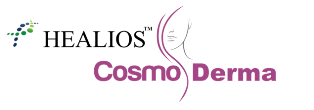Classification of acne in children
Pre-pubertal acne has been classified by age groups according to a panel convened by The American Acne and Rosacea Society
Neonatal acne — birth to six weeks of age
Neonatal acne is estimated to affect 20% of newborns. These take the form of comedones (whiteheads and blackheads) that extend from the scalp, upper chest, and back; and inflammatory lesions (erythematous papules and pustules) on the cheeks, chin and forehead. Neonatal acne can be mistaken for neonatal cephalic pustulosis (illustrated above).
Neonatal acne does not usually result in scarring. It is more likely to affect boys more than girls, at a rate of 5:1.
Infantile acne — six weeks to 1 year of age
Infantile acne is rare. It occurs in infants up to 16 months of age. It presents as comedones, papules, pustules and occasional nodules. It predominantly affects the cheeks. Occasionally, it leaves scarring.
Infantile acne can rarely persist until puberty, but it is not associated with underlying endocrine abnormalities. Male infants are affected more often than females, at a rate of 3:1.
Mid-childhood acne — 1 year to 6 years of age
Acne in this age group is very rare. An endocrinologist should be consulted to exclude possible hyperandrogenism.
Pre-adolescent — 7 years to 12 years (or up to menarche if female)
Acne can be the first sign of puberty, and it is common to find acne in this age group.
It often presents as comedones in the “T-zone”, the region of the face covering the central forehead and the central part of the face (brow, nose and lips).
What causes acne in children?
Neonatal acne is thought to be a result of hyperactive sebaceous glands in response to neonatal androgens, and maternal androgensthat have crossed through the placenta. Androgen levels wane after approximately 1 year. At around 7 years of age, androgenproduction restarts, with the onset of adrenarche.
From birth to around 6–12 months of age, luteinising hormone (LH) levels are similar to during puberty. In males, this results in increased testosterone production, and may explain the higher incidence of acne in boys of this age compared to girls.
Sebum production leads to increased colonisation of the hair follicles by the acne bacteria, P. acnes, and, as in adult acne, this results in follicular obstruction by sebum and keratin debris, and to inflammation.
How is acne in children diagnosed?
In pre-pubertal children with acne, a clinical history and examination may detect accelerated growth, early sexual development and signs of hyperandrogenism, such as hirsutism. Bone age x-ray of the left hand and a wrist x-ray should be considered for children with indications of accelerated growth.
The majority of children with acne will not require further investigations.
However, if findings on a clinical history and examination in children 1–6 years old indicate that further investigation is required, or if the acne is severe or unresponsive to treatment, an endocrinology referral may be required. The levels of the following hormones should be measured:
- Free and total testosterone
- Dehydroepiandrosterone (DHEA)
- Luteinising hormone
- Follicle-stimulating hormone (FSH)
- Prolactin
- 17-hydroxy-progesterone.
What is the treatment for acne in children?
Treatment for children with acne is generally the same as in adults with acne, with the exception of restrictions by age for tetracyclines. All treatments take at least one to two months to result in significant improvement.
Treatment of mild acne
General management involves gently washing the skin twice daily, and using oil-free moisturisers.
Avoid greasy emollients, hair pomades and use of comedogenic products on the affected area.
Benzoyl peroxide
Benzoyl peroxide is a topical antiseptic and is available as a wash, gel or lotion that can be bought over the counter. It can be used alone for mild acne, or in combination with oral therapy for more severe cases.
Benzoyl peroxide should be applied to all the areas affected by acne. If the skin is particularly sensitive, treatment can start with a low concentration of 2.5%, as higher concentrations are more likely to cause dryness and irritation.
Topical retinoids — tretinoin and adapalene
Topical retinoids are creams, lotions and gels enriched with a derivative of Vitamin A (tretinoin, adapalene). If the skin is sensitive, an oil-free moisturiser or sunscreen can be added.
A topical retinoid should be applied to the whole affected zone. It is often initially used two or three times a week, and applications are increased to daily as tolerated if there is no improvement.
Topical retinoids are also available in combination with benzoyl peroxide or a topical antibiotic.
Treatment of moderate acne
The treatment for children with moderate acne is 250–500 mg of the oral antibiotic, erythromycin, in single or split dosing. It is best used in combination with a topical regimen, such as benzoyl peroxide and/or a topical retinoid, to reduce P. acnes resistance.
Trimethoprim, and trimethoprim + sulphamethoxazole, have been used if there is bacterial resistance to erythromycin, or if erythromycin is contraindicated due to adverse effects. Doxycycline and minocycline should be used only in children over 12 years of age.
Isotretinoin is sometimes used in moderate acne when antibiotics and topical therapy have been unsuccessful.
Treatment of severe acne
The treatment of severe acne is the same as for moderate acne. Isotretinoin can be prescribed if there is an inadequate response to oral antibiotics.
Doses of isotretinoin ranging from 0.2 mg/kg/day to 1mg/kg/day have been used safely in infants (from 5 months of age) and in children with severe acne. The isotretinoin capsules can be frozen to make it easier to divide them into halves or quarters, and freezing can help mask its unpleasant taste.
Premature epiphyseal closure is a theoretical concern with isotretinoin, but it has only been reported once, when isotretinoin was used to treat acne in a 14 year-old male at a dose of 0.75 mg/kg/day.
Deep nodules can be treated by injections with low concentration intralesional triamcinolone acetonide (2.5 mg/mL).

 7975288129 / 7483528607
7975288129 / 7483528607
